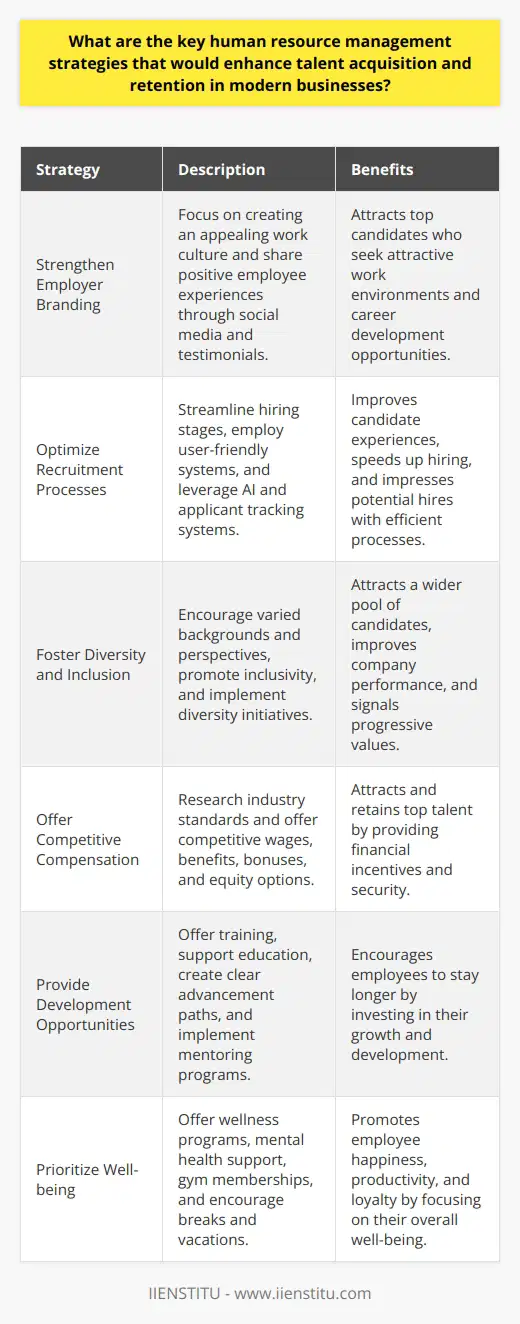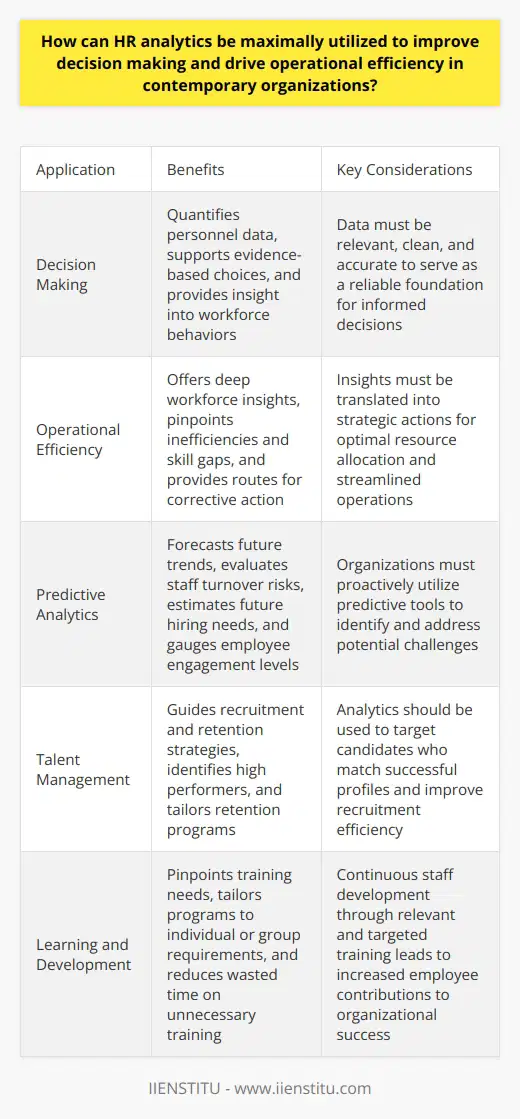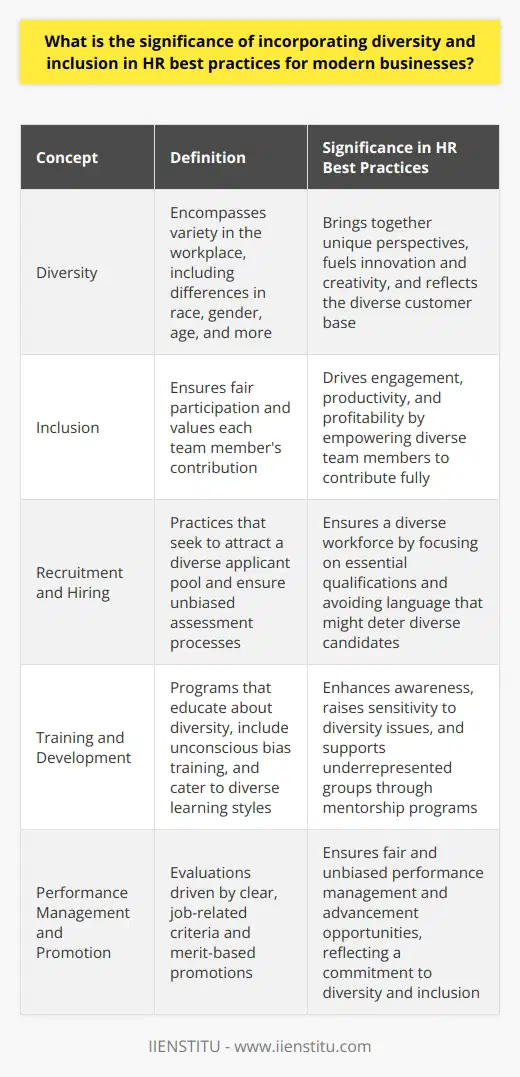
The realm of Human Resources (HR) has come to the forefront as a vital aspect of any successful business, demanding a blend of interpersonal skill, legal knowledge, and strategic acumen.
HR professionals stand at the intersection of a company's operations and its most valuable asset – its people. The role of HR extends past the rudimentary functions of hiring and firing, delving into shaping the organizational culture, driving employee engagement, and fostering an environment of continuous improvement and compliance.
The purpose of this blog is to distill HR best practices, ascertaining how they can be insightfully applied and implemented in the modern business milieu to enhance overall performance and sustain competitive advantage.
Understanding the Basics of HR
In its essence, HR represents the organizational function charged with maximizing employee performance in service of their employer's strategic objectives.
At its core, it is about establishing a symbiotic relationship where both the professional aspirations of employees and the operational targets of the organization are in unison. This entails a comprehensive grasp of the corporate landscape and a keen acumen that appreciates the nuanced interplay between various human capital elements.
Effective HR management is an indicator of a company's health and maturity. When executed with precision, HR can serve as a barometer for the broader organizational well-being, enabling leaders to calibrate their strategic direction and ensure alignment with their workforce.
It oversees numerous aspects like compliance with labor law, employee satisfaction, and helping to steer the company culture towards one that is conducive to high performance and growth.
The significance of HR in a business can be highlighted through the success story of a company like Google, which has consistently ranked highly for its innovative HR practices.
Google’s approach to continuous feedback, an open culture, and an inclusive work environment serves as a benchmark for how robust HR strategies can lead to outstanding business outcomes and substantial employee loyalty.
Major HR Functions and Responsibilities
Recruitment and Selection
The foundation of any thriving business is its workforce, making the recruitment and selection process one of HR's paramount functions.
Best practices in this domain involve a comprehensive understanding of the job requirements and a clear depiction of the candidate profile, all centralized in a talent acquisition strategy which aligns with the company’s ethos and aspirations. Employing techniques such as structured interviews and talent analytics can significantly enhance the efficacy of the recruitment process.
Creating an effective and fair selection process isn't merely about fulfilling immediate staffing needs; it’s about securing the long-term ambitions of the organization.
By stepping beyond the conventional hiring methods and embracing a more holistic view, companies can ensure they not only attract but also retain the right talent which will be instrumental in their progress.
Training and Development
The importance of continuous learning and professional growth cannot be overstated in today's fast-paced business environment. Companies with a strong ethos in employee development see marked improvements in innovation and adaptability.
Implementing effective training programs, moreover, should be carefully tailored to address the specific needs of employees and the strategic direction of the enterprise. Online certification courses have emerged as a powerful tool to offer personalized and scalable learning solutions that can keep the workforce up-to-date with the latest skills and knowledge.
Explore Essential Certificate Program:
Employee Relations
Employee relations encompass a broad spectrum of HR functions, acting as a liaison between employer and employee, and ensuring a harmonious organizational atmosphere.
The role of HR in conflict resolution is critical; fostering an environment where grievances are addressed proactively and equitably ensures a stable and productive workforce.
Effective strategies for maintaining positive employee relations often include regular communication, transparent processes, and an open-door policy.
Hrm Training And Development Strategies For New Age Businesses
The Role Of Corporate Hr İn Uniting Departments And Creating A Unified Hrm Strategy
Having mechanisms that encourage employee feedback and engagement demonstrates a commitment from the organization towards its workforce, subsequently boosting morale and loyalty.
Compensation and Benefits
One of the most tangible facets of HR's responsibilities is the management of compensation and benefits. Establishing a compensation package that is both fair and competitive is essential to attract and retain talent.
In sync with this, the strategic configuring and administering of employee benefits forms an integral part of the employer value proposition.
Managing these facets efficiently requires a keen sense of the market conditions and an understanding of the motivational drivers of the workforce.
The advent of various human resource management courses and training modules emphasizes the strategic nature and the complex balancing act HR professionals must perform to ensure a company's compensation structures remain enticing and sustainable.
HR Best Practices
Adopting best practices within the HR sphere often translates into tangible benefits for an organization, including increased productivity, enhanced employee engagement, and improved retention rates.
Implementing a strong recruitment strategy, therefore, becomes paramount, necessitating a thoughtful conglomerate of employer branding, sourcing methods, and candidate experience optimization.
Promoting a culture of continuous learning and development serves as another cornerstone of HR best practices. Harnessing the power of online certification courses and investing in employee growth not only future-proofs an organization’s talent but also contributes to its reputation as an employer of choice.
Culture and interpersonal dynamics round out the trifecta of HR expertise, with maintaining positive employee relations being a critical objective. HR's best practices here involve regular check-ins, conflict resolution protocols, and recognition programs that acknowledge and reward employee contributions.
A fair and competitive compensation and benefits program is also crucial. Organizations which navigate these tenets with acumen and sensitivity stand as beacons of HR excellence. Companies like SAS and Netflix have been exemplars, demonstrating the profound impact that innovative HR policies can have on corporate success.
The Future of HR
Technological advancements have already begun to reshape HR practices. From AI-driven analytics for talent acquisition to blockchain applications for secure and decentralized employee data management, the way HR operates is evolving.
As such, HR professionals must stay abreast of these technologies to optimize their functions and provide strategic value.
Moreover, the role of HR in a post-pandemic world has received renewed focus. Remote work, workforce health, and well-being, along with business continuity planning, have all emerged as pivotal concerns within HR's gamut. As workplace dynamics continue to shift, HR’s adaptability and innovation will be crucial.
Preparing for and adapting to future changes in HR involves a culture of learning and flexibility within the HR team itself. Embracing change, upskilling, and proactively addressing emerging workforce trends will ensure that HR remains a vital and vibrant contributor to business success.
As we have seen, HR best practices act as the linchpin for an organization's sustained performance and employee satisfaction. The multi-faceted roles and responsibilities of HR professionals require them to be arbitrators, strategists, and visionaries, adept at aligning people strategies with business objectives.
In recounting these best practices, we affirm the crucial role of HR in any successful business and underline the transformative potential these practices hold. To those reading, I encourage you to reflect on these insights and to equip your organizations with the necessary tools and approaches to ensure your HR functions are as robust and dynamic as the environment they operate in. The future of business depends on the strategic execution of HR best practices, and the endeavors we embark upon today will delineate the organizational landscapes of tomorrow.
Frequently Asked Questions
What are the key human resource management strategies that would enhance talent acquisition and retention in modern businesses?
Talent Acquisition Strategies
Strengthen Employer Branding
Employer branding is crucial. It attracts top candidates. They want appealing work cultures. Strong brands pull talent. Focus on branding messages. Use social media wisely. Share positive employee testimonials. Highlight work-life balance efforts. Showcase career development opportunities. This approach demands integrity. The brand must reflect reality.
Optimize Recruitment Processes
Efficiency is key. Simplified application processes are necessary. Streamline hiring stages. Employ user-friendly systems. Consider mobile application options. Adopt applicant tracking systems (ATS). Leverage artificial intelligence (AI). These improve candidate experiences. They also speed up hiring. Time saved impresses potential hires.
Foster Diversity and Inclusion
Diverse workplaces attract more candidates. They also perform better. Encourage varied backgrounds and perspectives. Promote inclusivity openly. It should be a clear priority. Training sessions may help. Diversity initiatives can be differentiators. They signal progressive company values.
Invest in Recruitment Marketing
Recruitment marketing is much like customer marketing. It aims at job seekers. Use targeted campaigns. Personalize outreach efforts. Understand different audience segments. Engage with them authentically. Tools like LinkedIn help. Recruitment marketing builds talent pipelines. It's not just about immediate hiring.
Talent Retention Strategies
Offer Competitive Compensation
Pay matters a lot. Research industry standards. Offer competitive wages. Consider total compensation packages. Include benefits like health care. Don't forget retirement plans. Performance bonuses can motivate. Equity options may also attract.
Provide Development Opportunities
Career progression is a magnet. Employees crave growth. Offer training and development. Support furthering education. Create clear advancement paths. Mentoring programs can support it. Invest in your people. They stay longer when growing.
Enculture Flexibility
Flexibility is a modern must-have. Offer remote work options. Flex-time can be vital. The pandemic changed expectations. Work-life balance is now critical. Flexible arrangements keep employees happy.
Recognize and Reward Performance
Acknowledge hard work. Praise achievements. Recognition boosts morale. Offer both formal and informal rewards. Celebrate successes. It shows appreciation. Employees feel valued. It encourages loyalty.
Encourage Employee Engagement
Engaged workers are committed. They provide better service. Cultivate a collaborative environment. Solicit their input. Listen to their feedback. Act on their suggestions. Engagement fosters retention. It makes employees feel heard.
Prioritize Well-being
Employee well-being is foundational. It impacts performance. Offer wellness programs. Consider mental health support. Provide gym memberships. Encourage breaks and vacations. Healthy employees are happier. They are also more productive.
Modern businesses must adapt. They require agile HR strategies. These strategies must align with new workforce demands. Only then can they truly succeed in talent acquisition and retention.

How can HR analytics be maximally utilized to improve decision making and drive operational efficiency in contemporary organizations?
Maximizing HR Analytics for Decision Making
To improve decision-making, HR analytics stands vital. It quantifies personnel data. This quantification supports evidence-based choices. Simply put, analytics provides insight into workforce behaviors. Data informs HR strategy formulation, enhancing the decision-making process.
Driving Operational Efficiency
Operational efficiency hinges on optimal resource use. HR analytics offers deep workforce insights. These insights translate into better resource allocation. They pinpoint inefficiencies and skill gaps, providing routes for corrective action. Such actions streamline operations, nurturing a productive environment.
Transforming Data into Strategy
Using HR analytics requires a tactical approach. It involves several steps for success. First, collect relevant data. This should cover the entire employee lifecycle. Second, ensure data integrity. Clean, accurate information serves as a reliable foundation.
Utilizing Predictive Analytics
HR analytics does not merely report. It predicts. Forecasts assist in identifying future trends. They illuminate paths organizations might take. Predictive tools play a central role. They evaluate staff turnover risks. They estimate future hiring needs. They also gauge employee engagement levels. With these, HR can act proactively, not reactively.
Improving Talent Management
Analytics transforms talent management. It guides recruitment and retention strategies. By analyzing workforce data, organizations identify high performers. Retention programs can then be tailored. Recruitment efficiency improves by targeting candidates who match successful profiles.
Streamlining Recruitment Processes
The hiring process can be lengthy. Analytics speeds it up. Analyzing application data eases talent spotting. It helps avoid poor hiring decisions. It reduces time-to-hire. All these factors give organizations a competitive edge.
Empowering Employees Through Analytics
Analytics also serve as an employee's advocate. They provide a voice for their experiences. By analyzing feedback, satisfaction levels surface. Leaders can address concerns promptly. This leads to a more contented and dedicated workforce.
Enhancing Learning and Development
Analytics pinpoint training needs. They help tailor programs to individual or group requirements. This makes learning more relevant. It reduces wasted time on unnecessary training. Employees grow. Their contributions to the organization's success grow too.
HR analytics offer sharp tools for smarter decision-making. They help leaders strategize with confidence. They aid in predicting patterns and trends. Improve hiring and talent management with analytics. Ensure continuous staff development. Used wisely, HR analytics drive operational efficiency. They serve employees and organizations alike. Embrace them well. Reap the benefits they offer.

What is the significance of incorporating diversity and inclusion in HR best practices for modern businesses?
Understanding Diversity and Inclusion in HR
Modern businesses face growing complexity. Markets diversify. Customer bases evolve. Workforces become more heterogeneous. These changes demand a fresh look at Human Resources (HR) practices. A significant shift toward diversity and inclusion has emerged.
The Imperative for Diversity
Diversity encompasses variety. In a workplace context, it implies a rich tapestry of differences. These include race, gender, age, and more. It brings together unique perspectives. This mix promises innovation. It fuels creativity.
A diverse team reflects the world it serves. It understands diverse customers better. It serves those customers with more empathy. Business success often depends on such understanding.
The Role of Inclusion
Inclusion ensures fair participation. It values each team member’s contribution. An inclusive environment empowers. It drives engagement. Workforce engagement links to productivity. It correlates with profitability, too.
Inclusion goes beyond just having a diverse team. It ensures that the diverse elements thrive. They must feel respected. They must feel valued. Only then will they contribute fully.
Best Practices for Incorporating Diversity and Inclusion in HR
Effective HR ensures diversity and inclusion in all practices. This approach covers recruitment, training, and career advancement. It seeks to eliminate bias. It promotes equal opportunity for all.
Recruitment and Hiring
Recruitment practices must be fair. They must seek to attract a diverse applicant pool. Job descriptions should focus on essential qualifications. They should avoid language that might deter diverse candidates. Assessment processes must be unbiased.
Training and Development
Training programs should educate about diversity. They should include unconscious bias training. Such training enhances awareness. It raises sensitivity to diversity issues. Development opportunities must be available to all. They should cater to diverse learning styles. Mentorship programs can support underrepresented groups.
Performance Management and Promotion
Performance management must occur without prejudice. Clear criteria should drive evaluations. These criteria should relate to job performance alone. Promotions should be merit-based. They should reflect a commitment to diversity and inclusion.
Leadership and Accountability
Leaders must champion diversity and inclusion. They must model inclusive behavior. Accountability structures should measure progress. These structures should reward inclusion efforts. They should also address shortcomings.
Diversity and inclusion are not just ethical imperatives. They are business necessities. They provide access to a broader talent pool. They open doors to more markets. They help to innovate product strategies. To reap these benefits, HR must integrate diversity and inclusion into every practice. Only then will businesses thrive in today's global marketplace.



